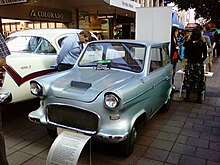Lightburn
Lightburn is the name of an Australian mechanical engineering company that mainly produces cement mixers, but also washing machines. The owner is Harold Lightburn . Mid-1960s, the company briefly operated as a car manufacturer and produced the odd shaped sedan Zeta Saloon . The brand name was Zeta . The cars were built in the washing machine factory in Camden Park near Adelaide and were offered for sale in 1963 at AU- £ 595. Production stopped in 1965 and the last vehicles were sold in 1966. In total, fewer than 400 cars were built.
Models
- two-door sedan , two-stroke engine with 324 cm³ displacement from Villiers , four-speed manual transmission (1964–1965)
- two-door luxury sedan, data as above (1964)
- two-seater sports roadster , two-stroke engine with 493 cm³ displacement from Sachs , four-speed manual transmission (1964)
- two-door pick-up mentioned in contemporary brochures; some vehicles were supplied from Sydney City for the Hyde Park fleet .
- two-seater, electric "runabout".
technology
The Zeta sedan, like the pick-up, was powered by a single-cylinder two-stroke Villiers engine with a displacement of 324 cc . The power of the engine installed in the front was transmitted to the front wheels via a four-speed manual transmission . The rear wheels were individually suspended from drawn trailing arms. The hatchback car had no tailgate. In order to get into the trunk, the seats had to be removed, which according to a relevant advertisement was particularly easy. The chassis was made of steel, the body made of GRP . The interior was relatively large, but sparingly equipped. The windshield was made of safety glass, the side and rear windows of Perspex . The doors were made of steel and had sliding windows.
The Zeta Sports had a two-cylinder -Zweitaktmotor Sachs. This motor has made 19.5 bhp (14.4 kW) at 5000 min -1 , driving the wheels through a four-speed manual transmission on. It was originally built for the Messerschmitt Tiger Tg 500 , had a 70 mm bore and 67 mm stroke and was interlocked with the gearbox. Production ran from 1963 to 1965. In 1964, 28 vehicles were sold.
According to the specification, the sedan and pick-up were fitted with Michelin 125 R 12 tires. The Villiers four-speed gearbox had no reverse gear. To drive backwards, the engine was switched off and started again in the opposite direction so that four gears were also available for reversing. The gasoline-oil mixture ran from the tank in front of the dashboard by gravity into the carburetor. A transparent hose, which was led from the bottom of the tank through the dashboard, served as the fuel gauge. A test by the automobile magazine Wheels says of the fuel gauge that "it showed something between full and empty, depending on the angle of inclination, throttle position and probably Greenwich Mean Time (GMT)".
The tiny sports model, which was not unlike the Goggomobil Dart, also built in Australia , had a two-cylinder Sachs engine with an interlocked gearbox. The design of its body was based on the Frisky from the British manufacturer Henry Meadows (Vehicles) Ltd. The car with a fiberglass body weighed 400 kg and had 10 ″ wheels with drum brakes all around. Like the dart, the car had no doors or bumpers.
Market success
"With the Zeta, however, failure was engineered into the product from day one." (German: With the Zeta, however, the failure was built into the product from day one.)
Not only the peculiar construction, but poor timing contributed to the car's commercial failure: it was launched at the same time as the Morris Mini , which was only AU- £ 60 more expensive than the Zeta. The appearance of an improved model with an externally revised, more pleasing design did not bring any improvement. Therefore, from 1963 to 1965 only 363 vehicles were sold, which already includes the Zeta Sports. Nevertheless, it is the only small Australian car that made it to series production, albeit modest.
literature
- Harald H. Linz, Halwart Schrader : The International Automobile Encyclopedia . United Soft Media Verlag, Munich 2008, ISBN 978-3-8032-9876-8 , chapter Zeta (II).
- George Nick Georgano (Editor-in-Chief): The Beaulieu Encyclopedia of the Automobile. Volume 2: G – O. Fitzroy Dearborn Publishers, Chicago 2001, ISBN 1-57958-293-1 , p. 900. (English)
Individual evidence
- ↑ Harald H. Linz, Halwart Schrader : The International Automobile Encyclopedia . United Soft Media Verlag, Munich 2008, ISBN 978-3-8032-9876-8 , chapter.
- ↑ 1967 Lightburn Runabout . Evalbum.com (English)
- ↑ a b According to an information board in the National Motor Museum in Birdwood, South Australia , a total of 48 Zeta Sports were built.
- ↑ Tony Davis: Extra Lemon . Bantam. Sydney (2005). Pp. 10-13. ISBN 1-86325550-8
- ↑ Tony Davis: Lemon! 60 Heroic Failures of Motoring . Random House Australia. P. 9
- ↑ George Nick Georgano (Editor-in-Chief): The Beaulieu Encyclopedia of the Automobile. Fitzroy Dearborn Publishers, Chicago 2001, ISBN 1-57958-293-1 , p. 900. (English)


